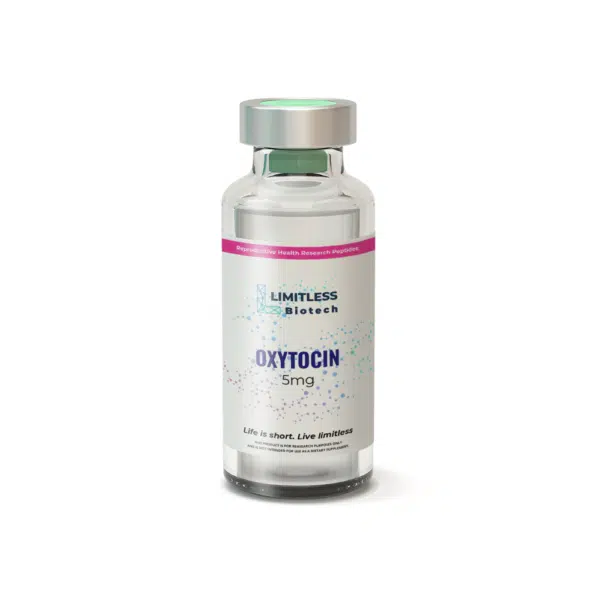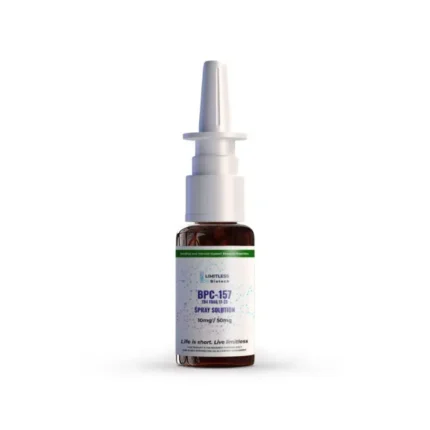Oxytocin research spans multiple biological systems, from basic receptor mechanisms to complex behavioral and physiological processes. These studies provide insight into the peptide’s diverse roles across neurobiological, metabolic, and cardiovascular systems.
Receptor Mechanisms and Neural Pathways
Oxytocin exerts its effects through specific G protein-coupled oxytocin receptors, influencing neuronal activity and neurotransmitter release[1]. The peptide’s C-terminal amidation structure is essential for biological activities, with secretion involving complex regulatory mechanisms including the CD38-cyclic ADP-ribose signal system[2].
Research has identified that oxytocin transport across the blood-brain barrier occurs through the RAGE receptor, which functions as a specific transporter[3]. Intranasal administration studies suggest effects may result from direct brain penetration or peripheral circulation with vagal stimulation via peripheral receptors[4].
Social Behavior Research
Studies demonstrate that oxytocin promotes maternal nurturing and bonding while increasing the salience of social stimuli[5]. The neuropeptide acts as a social facilitator by modulating emotional discrimination, social recognition, and social dominance[6].
Neuroimaging research reveals that oxytocin affects brain networks involved in social-emotional processing, particularly by reducing interference from hyperactivity in core emotional regions[7]. Enhanced approach behaviors and decreased withdrawal behaviors facilitate social interactions through reduced anxiety[8].
Recent studies have examined how oxytocin receptor gene variations interact with early bonding to shape social behaviors[9]. Research shows that oxytocin promotes social conformity by modulating neural responses to social misalignment[10].
Stress Response and HPA Axis
Oxytocin functions as a key modulator of the hypothalamic-pituitary-adrenal axis, influencing stress responses and emotional regulation. The neuropeptide interacts with the salience network and HPA axis to reduce psychosocial stress reactivity[11].
Studies examining oxytocin’s relationship with cortisol reveal complex interactions in stress buffering and promoting adaptive responses to social touch. The system provides flexible calibration of receptivity in social encounters based on environmental demands[12].
Pain Modulation Studies
Research shows that oxytocin modulates neural processes contributing to pain perception, with studies demonstrating reduced perceived pain intensity and altered cortical activity patterns following noxious stimulation[13][14].
The mechanisms involve interactions with opioid receptors, particularly mu and kappa opioid receptors in pain modulation pathways[15]. Oxytocin promotes prefrontal population activity via the paraventricular nucleus-prefrontal cortex pathway to regulate pain responses[16].
Studies show effectiveness in reducing heat pain responses through both peripheral mechanisms and central pain processing modifications[17].
Metabolic Effects of Oxytocin
Oxytocin emerges as a regulator of metabolic processes, potently reducing food intake through amplification of within-meal physiological satiation signals[18]. The peptide interacts with energy balance-associated systems including agouti-related peptide and melanin-concentrating hormone[19].
Studies reveal that oxytocin modulates mitochondrial biogenesis and enhances glucose uptake while optimizing energy utilization in key metabolic organs[20]. Oxytocin deficiency leads to late-onset obesity without increased food intake, suggesting reduced metabolic rate effects[21].
Research demonstrates that oxytocin influences lipolysis through peripheral sympathetic neurons, with oxytocin-producing sympathetic neurons regulating systemic metabolism[22].
Reproductive Biology
Oxytocin’s established roles encompass labor initiation, milk ejection, and maternal bonding. Studies show that oxytocin mediates key aspects of childbirth including onset of labor and initial breastfeeding[23].
Research examining milk ejection reflexes shows that oxytocin responses improve during early lactation, with frequency and amounts reaching maximum levels around day 10[24]. Studies indicate that both maternal and fetal oxytocin contribute to parturition processes[25].
Oxytocin can induce maternal behavior in virgin females, demonstrating the peptide’s role in facilitating maternal behavior through neurobiological mechanisms[26].
Neurodevelopmental Applications
Oxytocin research has expanded into autism spectrum disorder and neurodevelopmental conditions. Brain imaging research reveals that oxytocin modulates reward circuitry responses, particularly affecting nonsocial reward processing[27].
Studies examining oxytocin receptor density reveal altered receptor binding in specific brain regions including the nucleus basalis of Meynert and ventral pallidum[28]. Long-term studies demonstrate that continual treatment can attenuate amygdala activity while processing emotional states[29].
Genetic factors influence therapeutic effectiveness, with specific receptor gene polymorphisms predicting responses and emphasizing individual differences in underlying neuropeptide biology[30].
Cardiovascular Protection
Research shows that oxytocin protects against ischemia-reperfusion injury by reducing infarct size, inflammation, and apoptosis while improving functional recovery[31]. The cardioprotective mechanisms involve activation of reperfusion injury salvage kinase pathways[32].
Studies demonstrate that oxytocin stimulates stem cell differentiation to cardiomyocyte lineages and promotes angiogenesis through endothelial and smooth muscle cell generation. The peptide exhibits anti-inflammatory and antioxidant activities while influencing cardiovascular regulation[33].
Recent research reveals a novel brain-liver axis where oxytocin maintains cardiovascular health through lipid metabolism regulation[34]. Oxytocin controls bile acid production and lipoprotein lipase activity through peripheral oxytocin receptors in hepatocytes[31].
References
[1] Yuki Ueda, “Oxytocin: An expansive review of its mechanisms, functions, and therapeutic potential,” GSC Online Press, Jul. 2023. doi: 10.30574/wjarr.2023.19.1.1499. Available: https://doi.org/10.30574/wjarr.2023.19.1.1499
[2] H. Yonekura, I. Kato, Y. Yamamoto, T. Ikeda, H. Higashida, and H. Okamoto, “Biosynthesis and Function of VIP and Oxytocin: Mechanisms of C-terminal Amidation, Oxytocin Secretion and Transport,” The Endocrine Society, Aug. 2023. doi: 10.1210/endocr/bqad121. Available: https://doi.org/10.1210/endocr/bqad121
[3] Y. Yamamoto and H. Higashida, “RAGE regulates oxytocin transport into the brain,” Springer Science and Business Media LLC, Feb. 2020. doi: 10.1038/s42003-020-0799-2. Available: https://doi.org/10.1038/s42003-020-0799-2
[4] S. Yao and K. M. Kendrick, “Effects of Intranasal Administration of Oxytocin and Vasopressin on Social Cognition and Potential Routes and Mechanisms of Action,” MDPI AG, Jan. 2022. doi: 10.3390/pharmaceutics14020323. Available: https://doi.org/10.3390/pharmaceutics14020323
[5] N. Rigney, G. J. de Vries, A. Petrulis, and L. J. Young, “Oxytocin, Vasopressin, and Social Behavior: From Neural Circuits to Clinical Opportunities,” The Endocrine Society, Jul. 2022. doi: 10.1210/endocr/bqac111. Available: https://doi.org/10.1210/endocr/bqac111
[6] G. Coccia, F. La Greca, M. Di Luca, and D. Scheggia, “Dissecting social decision-making: A spotlight on oxytocinergic transmission,” Frontiers Media SA, Dec. 2022. doi: 10.3389/fnmol.2022.1061934. Available: https://doi.org/10.3389/fnmol.2022.1061934
[7] P. S. Churchland and P. Winkielman, “Modulating social behavior with oxytocin: How does it work? What does it mean?,” Elsevier BV, Mar. 2012. doi: 10.1016/j.yhbeh.2011.12.003. Available: https://doi.org/10.1016/j.yhbeh.2011.12.003
[8] S. Yao et al., “Oxytocin Facilitates Approach Behavior to Positive Social Stimuli via Decreasing Anterior Insula Activity,” Oxford University Press (OUP), Aug. 2018. doi: 10.1093/ijnp/pyy068. Available: https://doi.org/10.1093/ijnp/pyy068
[9] M. Lee, A. Lori, N. A. Langford, and J. K. Rilling, “Enhanced endogenous oxytocin signaling in the brain modulates neural responses to social misalignment and promotes conformity in humans: A multi-locus genetic profile approach,” Elsevier BV, Oct. 2022. doi: 10.1016/j.psyneuen.2022.105869. Available: https://doi.org/10.1016/j.psyneuen.2022.105869
[10] A. Bonassi, I. Cataldo, G. Gabrieli, J. N. Foo, B. Lepri, and G. Esposito, “Oxytocin Receptor Gene Polymorphisms and Early Parental Bonding Interact in Shaping Instagram Social Behavior,” MDPI AG, Oct. 2020. doi: 10.3390/ijerph17197232. Available: https://doi.org/10.3390/ijerph17197232
[11] L. M. Sippel, C. E. Allington, R. H. Pietrzak, I. Harpaz-Rotem, L. C. Mayes, and M. Olff, “Oxytocin and Stress-related Disorders: Neurobiological Mechanisms and Treatment Opportunities,” SAGE Publications, Feb. 2017. doi: 10.1177/2470547016687996. Available: https://doi.org/10.1177/2470547016687996
[12] L. Handlin, G. Novembre, H. Lindholm, R. Kämpe, E. Paul, and I. Morrison, “Human endogenous oxytocin and its neural correlates show adaptive responses to social touch based on recent social context,” eLife Sciences Publications, Ltd, May 2023. doi: 10.7554/elife.81197. Available: https://doi.org/10.7554/elife.81197
[13] C. Viero et al., “REVIEW: Oxytocin: Crossing the Bridge between Basic Science and Pharmacotherapy,” Wiley, Jul. 2010. doi: 10.1111/j.1755-5949.2010.00185.x. Available: https://doi.org/10.1111/j.1755-5949.2010.00185.x
[14] A. A. Mekhael et al., “Evaluating the efficacy of oxytocin for pain management: An updated systematic review and meta-analysis of randomized clinical trials and observational studies,” Informa UK Limited, May 2023. doi: 10.1080/24740527.2023.2191114. Available: https://doi.org/10.1080/24740527.2023.2191114
[15] M. Zubrzycka, J. Fichna, and A. Janecka, “Inhibition of trigemino-hypoglossal reflex in rats by oxytocin is mediated by mu and kappa opioid receptors.,” Brain Research, vol. 1035 1, pp. 67–72, 2005.
[16] Y. Liu et al., “Oxytocin promotes prefrontal population activity via the PVN-PFC pathway to regulate pain,” Elsevier BV, Jun. 2023. doi: 10.1016/j.neuron.2023.03.014. Available: https://doi.org/10.1016/j.neuron.2023.03.014
[17] B. Albinni et al., “Subcutaneous Oxytocin Injection Reduces Heat Pain: A Randomized-Controlled Trial,” Elsevier BV, Sep. 2024. doi: 10.1016/j.jpain.2024.104547. Available: https://doi.org/10.1016/j.jpain.2024.104547
[18] C. M. Liu, M. O. Spaulding, J. J. Rea, E. E. Noble, and S. E. Kanoski, “Oxytocin and Food Intake Control: Neural, Behavioral, and Signaling Mechanisms,” MDPI AG, Oct. 2021. doi: 10.3390/ijms221910859. Available: https://doi.org/10.3390/ijms221910859
[19] E. A. Lawson, “The effects of oxytocin on eating behaviour and metabolism in humans,” Springer Science and Business Media LLC, Sep. 2017. doi: 10.1038/nrendo.2017.115. Available: https://doi.org/10.1038/nrendo.2017.115
[20] Yuki Ueda, “Oxytocin: A key regulator of mitochondrial metabolism and energy homeostasis,” GSC Online Press, May 2024. doi: 10.30574/ijsra.2024.12.1.0734. Available: https://doi.org/10.30574/ijsra.2024.12.1.0734
[21] E. Li et al., “Control of lipolysis by a population of oxytocinergic sympathetic neurons,” Cold Spring Harbor Laboratory, Sep. 2022. doi: 10.1101/2022.09.27.509745. Available: https://doi.org/10.1101/2022.09.27.509745
[22] C. Camerino, “The New Frontier in Oxytocin Physiology: The Oxytonic Contraction,” MDPI AG, Jul. 2020. doi: 10.3390/ijms21145144. Available: https://doi.org/10.3390/ijms21145144
[23] M. H. Walter, H. Abele, and C. F. Plappert, “The Role of Oxytocin and the Effect of Stress During Childbirth: Neurobiological Basics and Implications for Mother and Child,” Frontiers Media SA, Oct. 2021. doi: 10.3389/fendo.2021.742236. Available: https://doi.org/10.3389/fendo.2021.742236
[24] J. A. Schriefer, P. R. Lewis, and J. W. Miller, “Role of Fetal Oxytocin in Parturition in the Rat1,” Oxford University Press (OUP), Sep. 1982. doi: 10.1095/biolreprod27.2.362. Available: https://doi.org/10.1095/biolreprod27.2.362
[25] R. C. Sutherland, E. S. Aizlewood, and J. B. Wakerley, “Changing characteristics of the milk-ejection reflex during pregnancy, lactation and after weaning in the rat,” Bioscientifica, Jan. 1986. doi: 10.1530/jrf.0.0760123. Available: https://doi.org/10.1530/jrf.0.0760123
[26] C. A. Pedersen and A. J. Prange, “Induction of maternal behavior in virgin rats after intracerebroventricular administration of oxytocin,” Proceedings of the National Academy of Sciences, Dec. 1979. doi: 10.1073/pnas.76.12.6661. Available: https://doi.org/10.1073/pnas.76.12.6661
[27] R. K. Greene et al., “The effects of intranasal oxytocin on reward circuitry responses in children with autism spectrum disorder,” Springer Science and Business Media LLC, Mar. 2018. doi: 10.1186/s11689-018-9228-y. Available: https://doi.org/10.1186/s11689-018-9228-y
[28] S. M. Freeman, M. C. Palumbo, R. H. Lawrence, A. L. Smith, M. M. Goodman, and K. L. Bales, “Effect of age and autism spectrum disorder on oxytocin receptor density in the human basal forebrain and midbrain,” Springer Science and Business Media LLC, Dec. 2018. doi: 10.1038/s41398-018-0315-3. Available: https://doi.org/10.1038/s41398-018-0315-3
[29] S. Bernaerts, B. Boets, J. Steyaert, N. Wenderoth, and K. Alaerts, “Oxytocin treatment attenuates amygdala activity in autism: a treatment-mechanism study with long-term follow-up,” Springer Science and Business Media LLC, Nov. 2020. doi: 10.1038/s41398-020-01069-w. Available: https://doi.org/10.1038/s41398-020-01069-w
[30] H. Kosaka et al., “Oxytocin efficacy is modulated by dosage and oxytocin receptor genotype in young adults with high-functioning autism: a 24-week randomized clinical trial,” Springer Science and Business Media LLC, Aug. 2016. doi: 10.1038/tp.2016.152. Available: https://doi.org/10.1038/tp.2016.152
[31] P. Wang et al., “Therapeutic Potential of Oxytocin in Atherosclerotic Cardiovascular Disease: Mechanisms and Signaling Pathways,” Frontiers Media SA, May 2019. doi: 10.3389/fnins.2019.00454. Available: https://doi.org/10.3389/fnins.2019.00454
[32] M. Jankowski, T. L. Broderick, and J. Gutkowska, “The Role of Oxytocin in Cardiovascular Protection,” Frontiers Media SA, Aug. 2020. doi: 10.3389/fpsyg.2020.02139. Available: https://doi.org/10.3389/fpsyg.2020.02139
[33] A. Szeto et al., “Oxytocin attenuates NADPH-dependent superoxide activity and IL-6 secretion in macrophages and vascular cells,” American Physiological Society, Dec. 2008. doi: 10.1152/ajpendo.90718.2008. Available: https://doi.org/10.1152/ajpendo.90718.2008
[34] S. Ko et al., “Social Bonds Retain Oxytocin-Mediated Brain-Liver Axis to Retard Atherosclerosis,” Ovid Technologies (Wolters Kluwer Health), Jan. 2025. doi: 10.1161/circresaha.124.324638. Available: https://doi.org/10.1161/circresaha.124.324638























Reviews
There are no reviews yet.